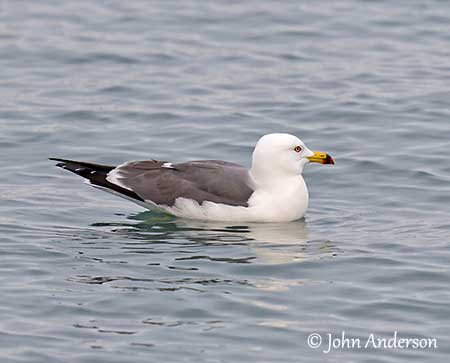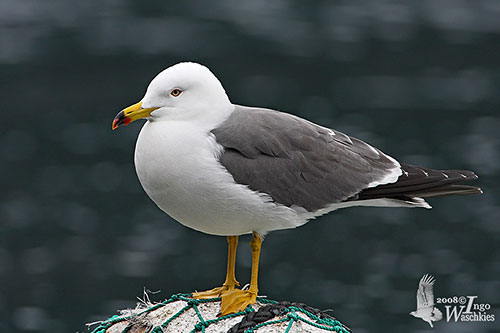
Fr: Goéland à queue noire
Ang: Black-tailed Gull
All: Japanmöwe
Esp: Gaviota Japonesa
Ita: Gabbiano codanera
Nd: Japanse Meeuw
Sd: svartstjärtad mås
Photographers:
John Anderson
John Anderson Photo Galleries
Didier Buysse
Vision d’Oiseaux
Jean Michel Fenerole
Photos d’Oiseaux du monde
Alan & Ann Tate
AA Bird Photography
Ingo Waschkies
Bird Photography
Texte de Nicole Bouglouan
Sources:
HANDBOOK OF THE BIRDS OF THE WORLD Volume 3 by Josep del Hoyo-Andrew Elliott-Jordi Sargatal - Lynx Edicions - ISBN : 8487334202
OISEAUX DE MER – Guide d’identification de Peter Harrison – Editions Broquet (Canada) – ISBN-10 : 2890004090 – ISBN-13 : 978-2890004092
Wikipedia, the free encyclopaedia
South Dakota Birds and Birding – (Terry L. Sohl)
What Bird-The ultimate Bird Guide (Mitchell Waite)
Black-tailed Gull
Larus crassirostris
Charadriiformes Order – Laridae Family
INTRODUCTION:
The Black-tailed Gull is native of eastern Asia and occurs in China, Taiwan, Japan and Korea where it is resident with some post-breeding dispersions.
It typically feeds on small fish, molluscs, crustaceans and carrion. It nests in dense colonies of up to 10,000 pairs on sea cliffs, rocky seashores and islets.
The Black-tailed Gull is not currently threatened and its population is suspected to be stable.
DESCRIPTION OF THE BIRD:
Biometrics:
Length: 43-51 cm
Wingspan: 126-128 cm
Weight: 436-640 g
The Black-tailed Gull in breeding plumage has slate-grey mantle and upperwing. The primaries are black with small white tips on 2-3 outermost flight-feathers. The upperwing-coverts and the secondaries are slate-grey, the latter with white tips. The relatively short tail is white with broad, subterminal black band and narrow white terminal band.
Head and underparts are white.
The bill is yellow with black subterminal ring and red spot at tip. The eyes are pale yellow, surrounded by narrow, red orbital ring. Legs and feet are yellow.

During winter, the white head is streaked dark grey but mostly on hindcrown, nape and around the eyes. The bill is duller, especially at tip.
Male and female are similar.
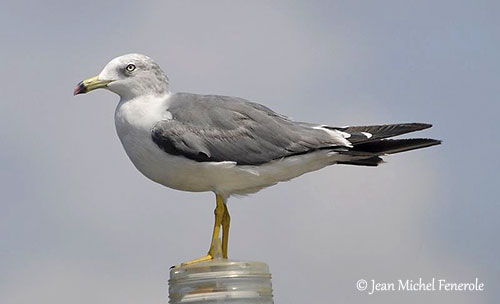
The juvenile is dark brown above, with buff to grey scaled pattern. The rump is paler. The uppertail-coverts are greyish-white with brown spots and bars. The upperwing shows blackish-brown flight-feathers and white-tipped secondaries. The upperwing-coverts are dull brown with buff or grey feather edges. The tail is blackish-brown with buff tip.
The underparts are white and slightly washed with brown.
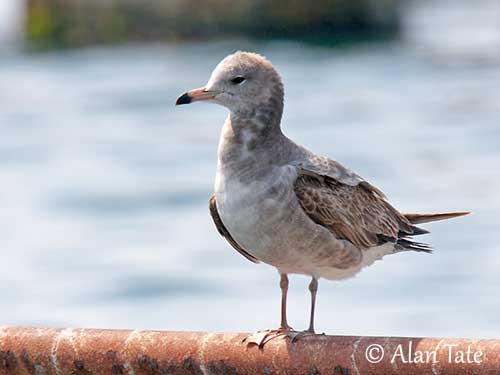
The first winter has uniform dark brown saddle and paler face.
The second winter resembles adult in winter, but the upperpart feathers may have brown tips.
The third winter resembles adult, but it shows dark markings on primary coverts, and the black tail bar is more extensive.
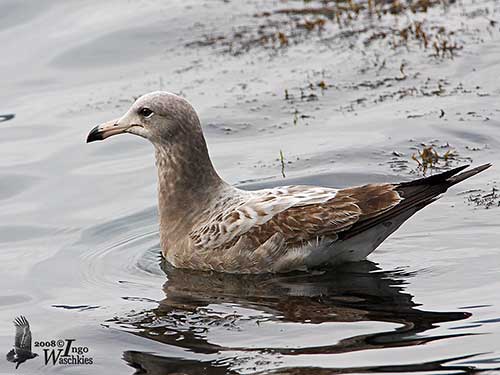
RANGE:
The Black-tailed Gull occurs in SE Russia, Japan, Korea and E China. During winter, it is found S to N East China Sea where it is more widespread, and in the Sea of Japan, and especially in the Korea Strait.
HABITAT:
The Black-tailed Gull breeds in dense colonies established on rocky coastal cliffs, sandy or rocky shorelines and rocky islets.
Outside of breeding season, it disperses and can be found well offshore, but they often remain in the same area in SE Asian waters.
CALLS AND SONGS: SOUNDS BY XENO-CANTO
The Black-tailed Gull is known for its harsh cat-like call, a deep mewing described as “kaoo kaoo, kau-kau” or “yark-yark-yark”. We can also hear a plaintive, rasping mewing.
This cat-like call gives the bird its Japanese name “Umineko” or Sea Cat, and its Korean name “Gwaeng-yi gull” meaning Cat Gull.
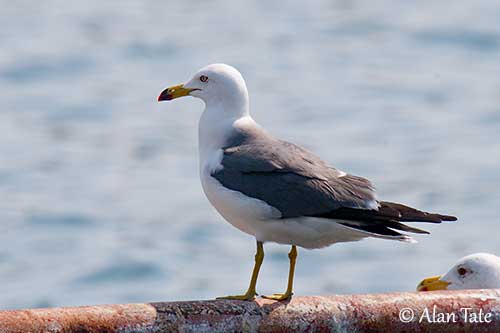
BEHAVIOUR IN THE WILD:
The Black-tailed Gull feeds on small fish, molluscs, crustaceans, insects, carrion and refuse. Insects can be caught in flight.
It usually forages both in water and on the ground by wading, swimming or walking. It may use various techniques such as surface-seizing, sometimes immersing, or plucks prey from water surface. It may use hard surfaces to break open shells, by dropping them onto these surfaces.
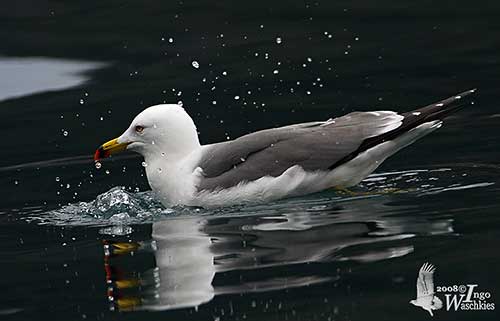
The Black-tailed Gull is monogamous and colonial breeder. The courtship behaviour is poorly known but we can suggest that both “Long call” and courtship feeding by male to female are part of the displays.
Gulls are usually very vocal during the breeding season. They defend a small area around the nest.
The Black-tailed Gull usually disperses after breeding, to reach good feeding areas. The Russian population of first year birds moves to the coast of Tatar Strait. The birds from NW Honshu move to the Pacific Coast of Honshu, Hokkaido and S Sea of Okhotsk. The population from the Yellow Sea migrates to S and N along the coast.
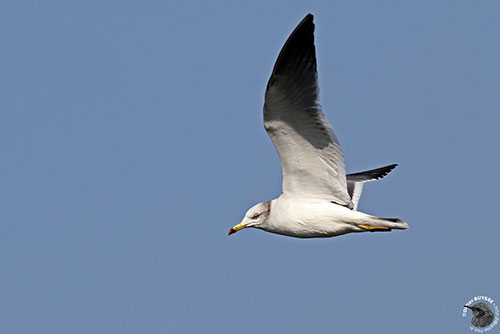
This species is vagrant to North America, Alaska, from S British Columbia S to California, and there are some inland records. They have also reached the Gulf of California, Mexico, Thailand and Australia. There are some rare records in Aleutians too, in Attu.
The flight of the Black-tailed Gull is powerful and elegant, like in numerous Laridae species.
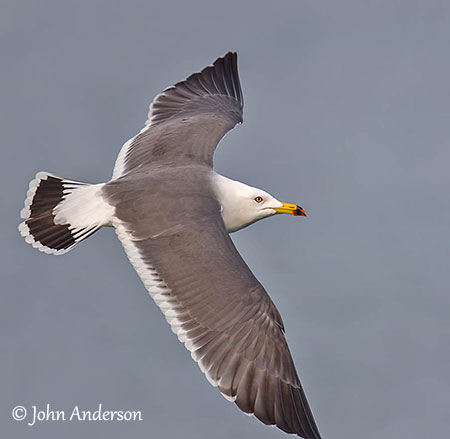
REPRODUCTION OF THIS SPECIES:
The breeding season takes place in spring/early summer. The colonies form in mid-April and the laying occurs in May-June in Siberia.
The colonies are established on sea cliffs, rocky or sandy seashores or rocky islets. They are usually dense with up to 10,000 pairs.
The nest is roughly made with dry grass, and placed on sandy or rocky substrate.
The female lays 2-3 whitish eggs with dark markings. The incubation lasts 24-25 days. At hatching, the downy chicks are greyish-buff with blackish spots on upperparts and throat. They fledge 35-40 days after hatching. Both parents feed and rear them.
PROTECTION / THREATS / STATUS:
The Black-tailed Gull is vulnerable to predation by Corvidae, and occasionally by gulls such as the Slaty-backed Gull, and also by feral cats.
The global population is estimated to number more than 1,100,000 individuals (2006). It is suspected to be stable.
The Black-tailed Gull is not globally threatened and currently evaluated as Least Concern.
